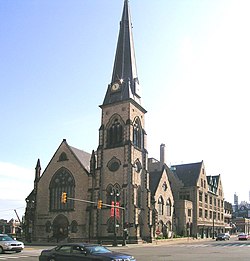Religious Structures of Woodward Avenue Thematic Resource
|
Religious Structures of Woodward Avenue TR
|
|

Central United Methodist Church from across Woodward
|
|
| Location | Detroit, Michigan |
|---|---|
| Coordinates | 42°22′50″N 83°4′46″W / 42.38056°N 83.07944°WCoordinates: 42°22′50″N 83°4′46″W / 42.38056°N 83.07944°W |
| Built | 1859–1929 |
| Architect | James Anderson, Sidney Rose Badgley, Hugh B. Clement, Ralph A. Cram, C. Howard Crane, Donaldson and Meier, J. Adam Fichter, William E. N. Hunter, Albert Jordan, Albert Kahn, Gordon W. Lloyd, Malcomson & Higginbotham, George D. Mason, James J. Nettleton, William H. Nicklas, Smith, Hinchman & Grylls, Guy J. Vinton, Henry A. Walsh |
| Architectural style | Tudor Revival, Gothic Revival, Romanesque Revival, Beaux Arts, Classical Revival, Other |
| MPS | Religious Structures of Woodward Avenue TR |
| NRHP Reference # | 82002893 - 82002896, 82002898, 82002899, 82002904, 82002905, 82002906, 82002908, 82002911, 82002912, 82002916, 82002918 - 82002921 |
| Added to NRHP | August 3, 1982 |
The Religious Structures of Woodward Avenue Thematic Resource (TR) is a multiple property submission to the National Register of Historic Places which was approved on August 3, 1982. The structures are located on Woodward Avenue in the cities of Detroit and Highland Park, Michigan.
In the early part of the 19th century, residential growth in Detroit occurred primarily east and west of Woodward, along Fort Street and Jefferson Avenue. Woodward Avenue was first developed as a residential district during the Civil War, as the downtown district became more business-oriented. By the turn of the century, Woodward was developed as far north as the present location of Interstate 94 as an upperclass residential section; mansions of society's elite were interspersed with architecturally significant churches. Although only a few of the mansions along Woodward remain (of the handful still extant, the David Whitney House, Col. Frank J. Hecker House, and Samuel L. Smith House are all on the National Register), many of the churches are represented in this TR.
After the turn of the century, and as the automobile expanded the scope of the city, Woodward rapidly changed character from an upscale residential area to a mix of commercial and multiple-family dwellings. Heirs to the 19th century mansions lining Woodward were already ensconced in their own homes in Boston-Edison, Arden Park-East Boston, or Virginia Park, and as the owners of the Woodward properties died, their homes were broken into apartments or razed. As congregants moved northward, more churches were established north of Grand Boulevard to serve people in the area. A string of churches were constructed in the 1920s and 1930s in this area.
...
Wikipedia


